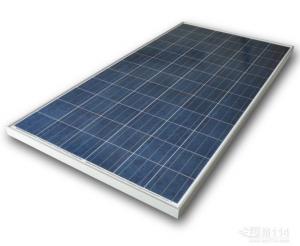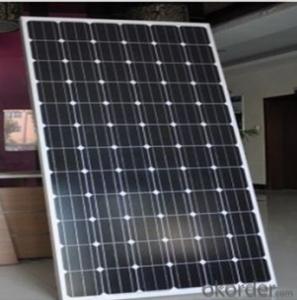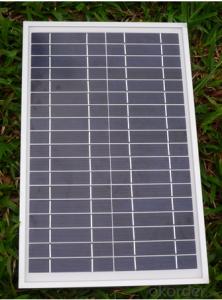Green Roof Compatible Poly Solar Panel 295W B Grade - Cheapest Price
- Loading Port:
- Shanghai
- Payment Terms:
- TT OR LC
- Min Order Qty:
- 100 watt
- Supply Capability:
- 10000 watt/month
OKorder Service Pledge
OKorder Financial Service
You Might Also Like
Specification
Poly Solar Panel 295W B Grade with Cheapest Price
Product description
A solar cell, or photovoltaic cell (in very early days also termed "solar battery"[1] – a denotation which nowadays has a totally different meaning, see here), is an electrical device that converts the energy of lightdirectly into electricity by the photovoltaic effect, which is a physical and chemical phenomenon.[2] It is a form of photoelectric cell, defined as a device whose electrical characteristics, such as current, voltage, or resistance, vary when exposed to light. Solar cells are the building blocks of photovoltaic modules, otherwise known as solar panels.
Solar cells are described as being photovoltaic irrespective of whether the source is sunlight or an artificial light. They are used as a photodetector (for example infrared detectors), detecting light or other electromagnetic radiation near the visible range, or measuring light intensity.
A photovoltaic (in short PV) module is a packaged, connected assembly of typically 6×10 solar cells. Solar Photovoltaic panels constitute the solar array of a photovoltaic system that generates and supplies solar electricity in commercial and residential applications. Each module is rated by its DC output power under standard test conditions, and typically ranges from 100 to 365 watts. The efficiency of a module determines the area of a module given the same rated output – an 8% efficient 230 watt module will have twice the area of a 16% efficient 230 watt module. There are a few solar panels available that are exceeding 19% efficiency. A single solar module can produce only a limited amount of power; most installations contain multiple modules. A photovoltaic system typically includes a panel or an array of solar modules, a solar inverter, and sometimes a battery and/or solar tracker and interconnection wiring.
Application
Business
Home
Industry
Large project
Feature
1. A grade high efficiency solar cells.
2.TUV/UL/CE/CEC etc
3.Fast shippment
4.25 years warranty
5.OEM/ODM
Packaging
28pcs into one carton
Shipping
Material in stock can be produced (procedure 5-20days) right away after pre-payment confirmation. COSCO Mearsk MSCship to worldwide for safe shipping, don't worry about package damage or loss. It takes about 15-40 days to worldwide, Please note us your contact details include your phone number for easy contacting from shipping company officer.
- Q: Do higher watt solar panels last longer, efficiency-wise? 3 installers gave me quotes with 3 different sunpower panels. The 225, 25, 20 watt panels. Whats the con and pro's of the different wattages?
- You should get the highest efficiency at the lowest price. Typically, the Sunpower brand panels have the industry best 23% efficiency depending on the model. You have to look at the specification very closely and if you don't see it, ask. There are two types of solar cells Polycrystalline and Monocrystalline. Polycrystalline cells are inferior to Monocrystalline. You will also see that different kinds of panels have different output voltages.Since you will be wiring your panels together and connecting them to either a power inverter or a charge controller (if you have battery backup), you need to make sure the panels and controller work together for maximum efficiency. Be very careful when engaging an installer especially when they are trying to sell you the equipment too. Mostly, these are not engineers and you will end up with whatever they have in stock without regard for the most optimal design.
- Q: Hi, I want to put some solar light in my yard, and wondering if a 00w solar panel could work for a few 3w dc lights....do i need a battery so they run at night, if so how many lights do u think i can run/ also i see elading solar light
- You can't really judge the watts for solar lighting the same way you could for dc lighting. This is because of several factors The lights that you showed ARE NOT high quality lights and furthermore; they are not a well-known brand. Also, I would be suspicious of any store that offers lights for less than half of what other stores do. They are dumping the merchandise, which means it could have been sitting around for a while. MAXSA Innovations makes good solar lamps, so does Solar Goes Green. As the other responder wrote, you are better off using dedicated solar spot lights or floodlights than trying to integrate a solar panel into regular solar lights. A 00 Watt solar panel is pretty strong, and you also would need a battery. Unless you know how to rig up the system with appropriate controllers to make sure too much energy doesn't get into the rechargeable battery (lithium ion or NiMH), you take a risk on having the whole system fry out.
- Q: So, I've seen cheap solar panel kits for sale from Harbor Freight, and regardless of whether or not I were to buy a set from them or someone else, I was wondering what the process of implementing a small-scale solar system into your household electrical system would be.I've read articles that started out too in-depth or were speaking of systems on a much larger scale.Can it be as easy as buying the panels and inverter, and plugging it into a socket, or is there more to it?Some of the articles I was reading had mentioned having to contract with your electrical supplier, having to have an electrician tie it all in in some special/ necessary way, using a battery pack (would this be necessary for a tied-in system?), or using the system to only power single items, like a water heater, or plugging items into a connected battery-pack, all of which I'm not sure is necessary or needed for what my goals/ means are/ would be.
- Grid tie inverters are expensive, but you might find a used one cheap on E-Bay, Crags list. Almost any grid tie inverter will work as you are thinking low power, but it likely needs to be 50 hertz or 60 hertz, which ever you have, and 230 volts ac or 20 volts ac which ever you have. It will work for a range of dc voltages, so your solar panels need to produce voltage near the center of that range. I considered buy the 3 PV panel set of 5 watt panels that Harbor freight sells. but I did not determine if the three panels can be conveniently connected in series to produce about 50 volts at light loads, or 00 volts if you buy two sets. You probably do not need the load controller, that comes with each set. I think most grid tie inverters automatically adjust to the dc voltage you supply them, unless it is below some minimum such as 50 volts. It is illegal to connect ordinary inverters to the power company, but they will probably not notice a small system unless you burn your house down. Most inverters will phase lock with the power companies frequency, but they are not designed to do that, so bad is likely unless you connect a resistor such as 0 ohms at 00 watts in series with the ac out of the inverter. If the resistor smokes you should disconnect promptly, then try again to see if you can get phase lock quickly. No smoke, likely means you are one of about 000 co-generators on the electric grid, You can short out the resistor with short piece of very fine wire which will hopefully melt if something goes wrong, such as the power company not sending electricity for 0. seconds or longer. Nearly all inverters have an over load feature, so the thin wire is a back up. Please be careful as people sometimes don't survive an electric shock at 20 volts.
- Q: My home uses an average of 2400 kW per month (28,800 per year.) How much can I expect it to cost to install solar panels of this amount? (It is not my intention to go off of the electric company's grid. I would like to generate what I can / possibly sell back extra power)What quot;hiddencosts are there? What is the average life of them?What is the quot;best(cost effective and green) solution / approach?(BTW.... I am in southern LA if that makes a difference)Best answer will go to clear answer WITH links/resources to back it up!)THANKS A MILLION!!! I hope you have a safe and happy holiday season!!!
- A solar system evolves many more components than just panels, and each with its own level of complexity and expense. Is electricity the only option for your consumption? I thought similarly yrs ago with my system, but now over the years the maintenance of panels, subpanels, charging systems, high effic batteries, etc has now proven to me that I should have ensured all other possible improvements be covered first to lower my overall uses.
- Q: i was told that by making a solar panel they cause more pollution than they will end up getting rid of. Is that true?
- The amount of energy needed to extract the raw materials from the Earth exceeds the amount the finished PV panels produce.Processing the materals takes additional energy.After manufacturing they have to be transported.Photovoltaic panels only generate </2 volt per square inch in bright sunlight.They become less efficient when they get dirty.
- Q: What is the impact of roof age on solar panels' efficiency?
- The age of a roof can have a significant impact on the efficiency of solar panels. An older roof may have deteriorated shingles or structural issues that can affect the installation and performance of solar panels. Additionally, an older roof may require repair or replacement in the near future, which would require removing and reinstalling the solar panels, incurring additional costs and potential damage. Therefore, it is important to ensure that the roof is in good condition before installing solar panels to maximize their efficiency and longevity.
- Q: How do I clean my solar panels?
- To clean your solar panels, you can start by rinsing them with a garden hose to remove any loose dirt or debris. If there are tougher stains or bird droppings, use a soft sponge or cloth with mild soapy water to gently scrub the surface. Avoid using abrasive materials or harsh chemicals that could damage the panels. Additionally, make sure to turn off the system and use caution when climbing on the roof. Regular cleaning every few months can help maintain optimal performance of your solar panels.
- Q: Can solar panels be used to power swimming pools?
- Yes, solar panels can indeed be used to power swimming pools. Solar panels can generate electricity from sunlight, which can be used to operate pool pumps, heaters, and other equipment, reducing the reliance on traditional electricity sources and saving on energy costs.
- Q: I've heard that solar panels have back-up batteries for when it is cloudy or rainy that day.. is this true?
- There okorder / Why pay thousands of dollars for solar energy ($27,000 average cost) when you can build your own solar panel system for just a fraction of the retail cost. You can build a single solar panel or you can build an entire array of panels to power your whole house. Some people are saving 50% on their power bill, some people are reducing their bill to nothing. But what’s most impressive is that just by following these instructions some are even making the power company pay them!
- Q: How do solar panels affect the energy independence of a building?
- Solar panels can greatly enhance the energy independence of a building by converting sunlight into electricity. By generating their own clean and renewable energy, buildings with solar panels can reduce or even eliminate their dependence on traditional energy sources like fossil fuels or the grid. This not only reduces the carbon footprint but also provides a sustainable and reliable source of power, ultimately granting greater energy independence to the building.
Send your message to us
Green Roof Compatible Poly Solar Panel 295W B Grade - Cheapest Price
- Loading Port:
- Shanghai
- Payment Terms:
- TT OR LC
- Min Order Qty:
- 100 watt
- Supply Capability:
- 10000 watt/month
OKorder Service Pledge
OKorder Financial Service
Similar products
Hot products
Hot Searches
Related keywords


























